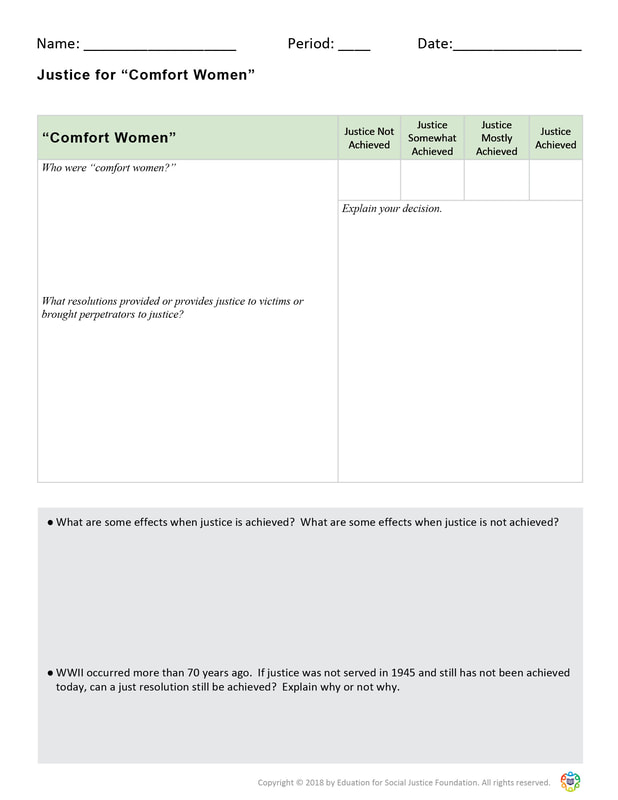Denial of Legal and Historical Responsibility
Purpose: Students should know what actions have been taken to obtain justice for “comfort women.” “Comfort women’s” ordeals, like many who are affected during wartime, did not end with the war. Students should be aware of “comfort women’s” past struggles and their present day struggles to obtain justice.
Objective: Students will be able explain key actions taken after WWII that attempted to achieve justice for “comfort women.” They should be able to defend their opinion on whether or not each resolution was appropriate using historical facts.
California Social Studies Content Standard: 10.4 New Imperialism - Students learn how colonization worked. Students also learn about Imperialism & its connection to race and religion 10.8 Causes and Consequences of WWII - Students analyze the causes and consequences of World War II. (Part of addressing that standard in the New HSS Curriculum Framework includes, “‘Comfort women’ is a euphemism that describes women who were forced into sexual service by the Japanese Army…”) 10.11 Economic Integration and Contemporary Revolutions in Information, Technology, and Communications - Students think about the following questions: Has the world become more peaceful? Is the nature of conflict changing? How do ideas about universal human rights relate to other value and identity systems in the contemporary world?
Suggested Time: 1-2 class day (approximately one to two hours)
Procedure:
· Teachers should inform students about the different demands for redress from former “comfort women,” the actions that have been taken, and the controversies that still persist around the issue of redress. They can:
o Give a short lecture, reading, or timeline that highlights the major actions taken. Some resources and more information are provided below.
· Students should fill in the worksheet. It can:
o be assigned as homework.
o be completed in small groups.
· After the worksheet is completed, the teacher should debrief the topic and the reflection questions by:
o having students discuss their answers in small groups.
o having a whole class discussion.
o having students line up as a continuum in the class depending on what they decided and have them explain their position.
· Teachers should have a sign on one side of the classroom that says “justice not achieved” and another sign on the other side of the room that says “justice achieved.” Students stand somewhere between the two points depending on their opinion.
Materials/Handouts:
“Justice for Comfort Women” worksheet
Some Resources (for teachers to prepare material for their students):
· “A Very Short History of Japan’s War Apologies” from the Washington Post: https://www.washingtonpost.com/news/worldviews/wp/2015/08/12/a-very-short-history-of-japans-war-apologies/?utm_term=.94dbe4262479
· “South Korea: World’s Longest Protest Over Comfort Women” from Al Jazeera: https://www.aljazeera.com/news/2017/09/south-korea-world-longest-protest-comfort-women-170908024721239.html
· “Japan’s divisive ‘comfort women’ fund” from the BBC: http://news.bbc.co.uk/2/hi/asia-pacific/6530197.stm
· “A Lifetime Later, a Korean ‘comfort woman’ still seeks redress” from CNN: https://www.cnn.com/2015/04/29/asia/will-ripley-japan-comfort-women/index.html
· Jan Ruff-O’Herne’s testimony to the U.S. House of Representatives in 2007: http://www.alpha-canada.org/wp-content/themes/bcalpha-theme/Testimonies/CWH_Jan%20Ruff%20O'Herne.pdf
· “Report on the mission to the Democratic People’s Republic of Korea the Republic of Korea, and Japan on the issue of military sexual slavery in wartime” from the UN Commission on Human Rights: http://hrlibrary.umn.edu/commission/country52/53-add1.htm
· Filipino Comfort Women: https://www.huffingtonpost.com/entry/comfort-women-philippines-m-evelina-galang_us_57232d48e4b0f309baf08490
· “Deal with Japan on Former Sex Slaves Failed Victims, South Korean Panel Says” from New York Times: https://www.nytimes.com/2017/12/27/world/asia/comfort-women-south-korea-japan.html
· Yongsoo Lee’s confrontation with South Korean Foreign Minister over the 2015 agreement: https://www.youtube.com/watch?time_continue=106&v=PoScD0NUfmA
Additional resources can be found at the end of this Resource Guide in the “References” section.
Objective: Students will be able explain key actions taken after WWII that attempted to achieve justice for “comfort women.” They should be able to defend their opinion on whether or not each resolution was appropriate using historical facts.
California Social Studies Content Standard: 10.4 New Imperialism - Students learn how colonization worked. Students also learn about Imperialism & its connection to race and religion 10.8 Causes and Consequences of WWII - Students analyze the causes and consequences of World War II. (Part of addressing that standard in the New HSS Curriculum Framework includes, “‘Comfort women’ is a euphemism that describes women who were forced into sexual service by the Japanese Army…”) 10.11 Economic Integration and Contemporary Revolutions in Information, Technology, and Communications - Students think about the following questions: Has the world become more peaceful? Is the nature of conflict changing? How do ideas about universal human rights relate to other value and identity systems in the contemporary world?
Suggested Time: 1-2 class day (approximately one to two hours)
Procedure:
· Teachers should inform students about the different demands for redress from former “comfort women,” the actions that have been taken, and the controversies that still persist around the issue of redress. They can:
o Give a short lecture, reading, or timeline that highlights the major actions taken. Some resources and more information are provided below.
· Students should fill in the worksheet. It can:
o be assigned as homework.
o be completed in small groups.
· After the worksheet is completed, the teacher should debrief the topic and the reflection questions by:
o having students discuss their answers in small groups.
o having a whole class discussion.
o having students line up as a continuum in the class depending on what they decided and have them explain their position.
· Teachers should have a sign on one side of the classroom that says “justice not achieved” and another sign on the other side of the room that says “justice achieved.” Students stand somewhere between the two points depending on their opinion.
Materials/Handouts:
“Justice for Comfort Women” worksheet
Some Resources (for teachers to prepare material for their students):
· “A Very Short History of Japan’s War Apologies” from the Washington Post: https://www.washingtonpost.com/news/worldviews/wp/2015/08/12/a-very-short-history-of-japans-war-apologies/?utm_term=.94dbe4262479
· “South Korea: World’s Longest Protest Over Comfort Women” from Al Jazeera: https://www.aljazeera.com/news/2017/09/south-korea-world-longest-protest-comfort-women-170908024721239.html
· “Japan’s divisive ‘comfort women’ fund” from the BBC: http://news.bbc.co.uk/2/hi/asia-pacific/6530197.stm
· “A Lifetime Later, a Korean ‘comfort woman’ still seeks redress” from CNN: https://www.cnn.com/2015/04/29/asia/will-ripley-japan-comfort-women/index.html
· Jan Ruff-O’Herne’s testimony to the U.S. House of Representatives in 2007: http://www.alpha-canada.org/wp-content/themes/bcalpha-theme/Testimonies/CWH_Jan%20Ruff%20O'Herne.pdf
· “Report on the mission to the Democratic People’s Republic of Korea the Republic of Korea, and Japan on the issue of military sexual slavery in wartime” from the UN Commission on Human Rights: http://hrlibrary.umn.edu/commission/country52/53-add1.htm
· Filipino Comfort Women: https://www.huffingtonpost.com/entry/comfort-women-philippines-m-evelina-galang_us_57232d48e4b0f309baf08490
· “Deal with Japan on Former Sex Slaves Failed Victims, South Korean Panel Says” from New York Times: https://www.nytimes.com/2017/12/27/world/asia/comfort-women-south-korea-japan.html
· Yongsoo Lee’s confrontation with South Korean Foreign Minister over the 2015 agreement: https://www.youtube.com/watch?time_continue=106&v=PoScD0NUfmA
Additional resources can be found at the end of this Resource Guide in the “References” section.
Extension: Has justice been achieved for "comfort women"?
Copyright Ⓒ 2018 Education for Social Justice Foundation. All rights reserved.



